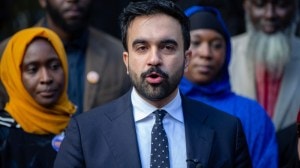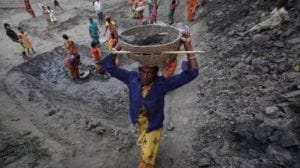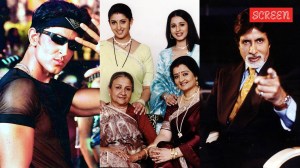Moditva’s fading echo in Mumbai
Today, when Narendra Modi is in the news for his ugly election rhetoric at Mangrol...

Today, when Narendra Modi is in the news for his ugly election rhetoric at Mangrol, Mumbaikars remember his address at Mumbai’s Shivaji Park in January 2003. It was vintage Modi alright: he placed all those who attack Hindutva on a par with Pakistan and exhorted his audience to “use all means” to undermine those who attack it. From the crowds who came to listen to him, it was clear that the Gujarat chief minister had a significant support base in Mumbai, what with its large proportion of Gujaratis. The question is whether that support base is growing or waning. I would argue that the decline has begun.
But first let us briefly look at the larger historical canvas. Most Mumbaikars, who are primarily from the Marathi community, regard the Gujaratis in the city as businessmen — entrepreneurs, traders, stock brokers. Quite often, the Marwaris are also clubbed along with the Gujaratis. Although Mumbai is known nationally and globally as a city that is driven by business, there is also a strong socio-cultural undercurrent that regards such activities with disdain. This is a legacy of the socialist-communist trade union movement which dominated the organised industrial life of Mumbai until the mid-eighties. The Marathi proletariat and intelligentsia shared this perception and sometimes exhibited a quiet but distinct resentment towards the Gujaratis/Marwaris. What fostered the hostility was the fact that most of the textile mills were owned by Gujaratis/Marwaris, as indeed most of the shops, particularly ‘kirana’ stores. Gujaratis/Marwaris also dominated the stock market. On Dalal Street, the lingua franca was always Gujarati.
There are about 35 to 40 lakh Gujaratis in Mumbai. Since the current population of the city is around 1.5 crore, this means that a little less than 25 per cent are Gujaratis. When the state of Maharashtra was carved out in 1960, with Mumbai as its capital, the percentage of the Gujaratis was 35 per cent.
However, the perception that the entire Gujarati community is ‘business-minded’ is a stereotype and like all stereotypes misleading. Equally misleading is the idea that the Gujaratis in Mumbai constitute a ‘Little Gujarat’ in the metropolis. Those who argue that Mumbai’s Gujaratis are partial to Modi, base their argument on this false premise. The fact is that the Gujarati community is not socially or economically homogenous, although it may appear so to those watching mass garba performances during the navaratras. The popular image of the community is essentially that of the middle-class Gujarati. But there are also Gujaratis who belong to the lower caste and work as safai kamgars (primarily Meghwals). Their number is not small. Then there are thousands of Gujarati workers and white-collar employees who work in a variety of trading establishments. There are the craftsmen working in the diamond industry. The Gujarati middle class, perceived as business-minded, constitute only about 50 per cent of the community.
When it comes to politics, the Gujarati community is also not as homogenous as is generally believed. For instance, it is not generally known that the Patel community, even in Mumbai, is disturbed by Modi’s authoritarian style. The Gujaratis in Mumbai who have come from Saurashtra, and elsewhere, tend to follow political developments back home. There is, at present, tremendous discontent over Modi’s politics among Mumbai’s Saurashtra Gujaratis.
The relationship that Gujaratis have with Mumbai goes back into history. The post-Independence years saw a rise in migration from Gujarat to Mumbai, with people coming in search of jobs or business opportunities. That trend slowed down a little after the formation of two states. During the past 25 years, more Gujaratis have perhaps migrated to the US than to Mumbai.
The city was and continues to be bilingual, with its first language Marathi; its second, Gujarati. The state also had its fair share of Gujarati politicians, foremost among them the redoubtable Morarji Desai. It must also be remembered that the Gujaratis in Mumbai had not demanded a separate state for the Gujarati-speaking people. The demand for Maharashtra, with Mumbai as the inseparable part of the state, was that of the Marathi-speaking people.
In the Bombay of the fifties and the sixties, the traditional rivalry between the Marathi and Gujarati communities got defined along political lines. The Congress was seen as representing the interests of the Gujarati trader and industrialist — the ‘capitalist class’ — and the unionised Marathi community was mobilised under the communist banner. This underwent a sea-change in the eighties and the nineties. Following the alliance of the BJP and Shiv Sena, the Marathi and Gujarati communities came together politically.
The Congress party may not be a favourite with Mumbai’s Gujarati middle class today, but at one point in time —before their political migration to the BJP in the nineties — Mumbai’s Gujaratis had claimed the Gandhi-Nehru-Patel legacy as their own. Over the years, the Sangh Parivar succeeded in appropriating Vallabhbhai Patel’s image, making it appear as if the iron man was a disciple of Sriguru Golwalkar! When the neo-Hindutva movement became strident in the late eighties and early nineties — along with the Ayodhya agitation — Gujaratis in Mumbai, with their NRI counterparts and compatriots in the state, turned to militant Hindutva. The decade which began in 1992 — the Babri demolition — and ended with the 2002 Gujarat pogrom under Modi, saw the high tide of this militant phase. But as time went by, things got far more complex. Today, while the Congress continues to be viewed with scepticism, there is palpable discontent with the negative aspects of hardline Hindutva politics, and its proponents like Modi.
History teaches us that those who practise extreme politics end up digging their own graves. Among Mumbai’s Gujaratis, the disenchantment with Moditva is palpable. He may or may not win the December election, but if the mood in Mumbai is any gauge, the unravelling of the man’s political mystique has begun.
The writer is editor, ‘Loksatta’ kumar.ketkarexpressindia.com




- 01
- 02
- 03
- 04
- 05



























